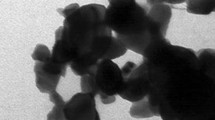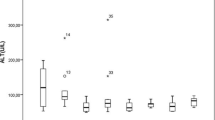Abstract
The objective of this study was to evaluate the effects of different doses of 2,4-dichlorophenoxyacetic herbicide in rat hearts. Exposure was through rat food that was nebulized with the herbicide. Thirty adult male Wistar rats (200–300 g) were used. The diet was exposed to 2,4-D in two different doses (CG: control group 10 ml distilled water; LCG: low concentration group 3.71 × 10−3 g.ia/ha diluted in 10 ml saline at 0.9% and HCG: High concentration group 9.28 × 10−3 g.ia/ha diluted in 10 ml 0.9% saline). After 6 months of exposure, blood samples were collected for CKMB evaluation, and left ventricular fragments were analyzed by histological evaluation, fibrosis measurements, fractal dimension and immunohistochemistry (BAX, Bcl2, TNF-α and NF-kB). There were no significant changes in CK-MB concentration, histological parameters, fibrosis measurements and fractal dimension. Long-term oral consumption of food nebulized by the herbicide 2,4-D promoted an increase in BAX, Bcl-2/BAX, and cytoplasmic NF-kB in the nuclear area of the group that received the highest dose of the herbicide. This suggests that the herbicide induces cardiotoxicity.




Similar content being viewed by others
References
Abdolghaffari AH, Baghaei A, Solgi R, Gooshe M, Baeeri M, Navaei-Nigjeh M, Hassani S, Jafari A, Rezayat SM, Dehpour AR, Mehr SE, Abdollahi M (2015) Molecular and biochemical evidences on the protective effects of triiodothyronine against phosphine-induced cardiac and mitochondrial toxicity. Life Sci 139:30–39. https://doi.org/10.1016/j.lfs.2015.07.026
Adriana J, Cicogna AC, Engel LE et al (2016) Effects of growth hormone on cardiac remodeling during resistance training in rats. Arq Bras Cardiol 106(1):18–25. https://doi.org/10.5935/abc.20160003
Alavanja MC, Ross MK, Bonner MR (2013) Increased cancer burden among pesticide applicators and others due to pesticide exposure. CA Cancer J Clin 63(2):120–142. https://doi.org/10.3322/caac.21170
Amara IB, Soundani N, Hakim A (2013) Protective effects of vitamin E and selenium against dimethoate-induced cardiotoxicity in vivo: biochemical and histological studies. EnvironToxicol. 28(11):630–643. https://doi.org/10.1002/tox.20759
Asmarinah A, Paradowska-Dogan A, Kodariah R, Tanuhardja B, Waliszewski P, Mochtar CA, Hinsch E (2014) Expression of the Bcl-2 family genes and complexes involved in the mitochondrial transport in prostate cancer cells. Int J Oncol 45(4):1489–1496
Bener A, Lestringant GG, Beshwari MM, Pasha MA (1999) Respiratory symptoms, skin disorders and serum IgE levels in farm workers. Allerg Immunol 31(2):52–56
Curl CL, Fenske RA, Kissel JC, Shirai JH, Moate TF, Griffith W, Coronado G, Thompson B (2002) Evaluation of take-home organophosphorus pesticide exposure among agricultural workers and their children. Environ Health Perspect 110:A787–A792. 1981. https://doi.org/10.1289/ehp.021100787
Cury SS, Freire PP, Martinucci B, Dos Santos VC, de Oliveira G, Ferretti R, Dal-Pai-Silva M, Pacagnelli FL, Delella FK, Carvalho RF (2018) Fractal dimension analysis reveals skeletal muscle disorganization in mdx mice. Biochem Biophys Res Commun 503(1):109–115. https://doi.org/10.1016/j.bbrc.2018.05.189
Dinis-Oliveira RJ, Pontesa H, Bastos ML, Remião F, Duarted JA, Carvalhoa F (2009) An effective antidote for paraquat poisonings: the treatment with lysine acetylsalicylate. Toxicology 255:187–193. https://doi.org/10.1016/j.tox.2008.10.015
Dhingra R, Shaw JA, Aviv Y, Kirshenbaum LA (2010) Dichotomous actions of NF-kappaB signaling pathways in heart. J Cardiovasc Transl Res 3:344–354. https://doi.org/10.1007/s12265-010-9195-5
European Commission Directorate General for Health and Food Safety (2016) Final review report for the active substance 2,4-D. SANCO/11961/2015 Rev 3 final Ed. Standing Committee on Plants, Animals, Food and Feed.
Frenzel A, Grespi F, Chmelewskij W, Villunger A (2009) Bcl2 family proteins in carcinogenesis and the treatment of cancer. Apoptose 14(4):584–596. https://doi.org/10.1007/s10495-008-0300-z Gordon et al. 2011
Gordon, JW, Shaw JA, Kirshenbaum LA. (2011) Multiple facets of NF-κB in the heart: to be or not to NF-κB. Circ Res.; 29;108(9):1122-32. https://doi.org/10.1161/CIRCRESAHA.110.226928.
Goren N, Cuenca J, Martin-Sanz P, Bosca L (2004) Attenuation of NF-kappaB signalling in rat cardiomyocytes at birth restricts the induction of inflammatory genes. Cardiovasc Res 64:289–297
Grewal KK, Sandhu GS, Kaur R, Brar RS, Sanshu HS. (2010) Toxic impacts of cypermethrin on behavior and histology of certain tissues of albino rats. Toxicol Int 17(2):94–98. https://doi.org/10.4103/0971-6580.72679
Janicki PK, Paulo EA, Pasierbski W, Rutczyńska Z, Szreniawski Z (1986) Interactions between herbicides and various of the most frequently used drug groups. I. Interactions between chronically administered herbicides: carbendazyme, 2,4-dichlorophenoxyacetic acid and 2,4,5-trichlorophenoxyacetic acid and drugs affecting the circulatory system. Med Pr 37(3):167–174
Kaltschmidt B, Ndiaye D, Korte M, Pothion Ś, Arbibe L, Prüllage M, Pfeiffer J, Lindecke A, Staiger V, Israël A, Kaltschmidt C, Mémet S (2006) NF-κB regulates spatial memory formation and synaptic plasticity through protein kinase A/CREB signaling. Mol Cell Biol 26(8):2936–2946
Korsmeyer SJ (1999) BCL-2 gene family and the regulation of programmed cell death. Cancer Res 59(7 Suppl):1693s–1700s
Kyrylkova K, Kyryachenko S, Leid M, Kioussi C (2012) Detection of apoptosis by TUNEL assay. Odontogenesis 887:41–47. https://doi.org/10.1007/978-1-61779-860-3_5
Marouani N, Tebourbi O, Cherif D, Hallegue D, Yacoubi MT, Sakly M, Benkhalifa M, Ben Rhouma K (2016) Effects of oral administration of 2,4-dichlorophenoxyacetic acid (2,4-D) on reproductive parameters in male Wistar rats. Environ Sci Pollut Res 24(1):519–526. https://doi.org/10.1007/s11356-016-7656-3
Mello F, Quinallia G, Marion AC et al (2018) Evaluation of the nasal cavity of mice exposed to exposure to 2,4-chlorophenoxyacetic acid herbicide. Medicine (Ribeirão Preto Online) [Internet] 51(4):247–253
Ministry of Health (2005) Laboratory animal handling course. Gonçalo Muniz Research Center. http://www.bioteriocentral.ufc.br/arquivos/apostilha_manipulacao.pdf. Accessed March 25, 2018
Moreira RD, Moriel AR, Murta Junior LO, Neves LA, Godoy MF (2011) Fractal dimension in quantifying the degree of myocardial cellular rejection after cardiac transplantation. Rev Bras Cir Cardiovasc 26(2):155–163. https://doi.org/10.1590/S0102-76382011000200004
Morrison H, Savitz D, Semenciw R et al (1993) Farming and prostate cancer mortality. Am J Epidemiol 137:270–280. https://doi.org/10.1093/oxfordjournals.aje.a116674
Oliveira MAB, Brandi AC, Santos CA, Botelho PHH, Cortez JLL, Godoy MF, Braile DM (2014) Comparison of fractal dimension and Shannon entropy in myocytes from rats treated with histidine-tryptophan-glutamate and histidinetryptophan cetoglutarate. Rev Bras Cir Cardiovasc 29(2):156–162. https://doi.org/10.5935/1678-9741.20140052
Pacagnelli FL, Sabela AKDA, Mariano TB et al (2016) Fractal dimension in quantifying experimental-pulmonary hypertension-induced cardiac dysfunction in rats. Arq Bras Cardiol 107(1):33–39. https://doi.org/10.5935/abc.20160083
Parizi JLS, Tolardo AJ, Lisboa ACG, Barravieira B, Mello FZ, Rossi RC, Nai GA. Evaluation of buccal damage associated with acute inhalation exposure to 2,4- dichlorophenoxyacetic acid (2,4-D) in mice. BMC Vet Res 16:244. https://doi.org/10.1186/s12917-020-02461-w.
Pinheiro DG, Oliveira GLF, Perrud SN et al (2018) Cardiac analysis of rats subjected to chronic exposure of the herbicide dichlorophenoxyacetic acid (2,4-D). Colloq Vitae 10(3):1–6. https://doi.org/10.5747/cv.2018.v10.n3.v236
Razavi BM, Hosseinzadeh H, Movassaghi AR, Imenshahidi M, Abnous K (2013) Protective effect of crocin on diazinon induced cardiotoxicity in rats in subchronic exposure. Chem Biol Interact 203:547–555. https://doi.org/10.1016/j.cbi.2013.03.010
Razavi BM, Hosseinzadeh H, Imenshahidi M (2015) Evaluation of protein ubiquitylation in heart tissue of rats exposed to diazinon (an organophosphate insecticide) and crocin (an active saffron ingredient): role of HIF-1α. Drug Res (Stuttg) 65(11):561–566. https://doi.org/10.1055/s-0034-1384533
Rivera-Serrano EE, Sherry B (2017) NF-κB activation is cell type-specific in the heart. Virology 502(133):143. https://doi.org/10.1016/j.virol.2016.12.022
Schreinemachers DM (2003). Birth malformations and other adverse perinatal outcomes in four U.S. Wheat-producing States. Environ Health Perspect 111(9):1259–1264. https://doi.org/10.1289/ehp.5830
Scorrano L, Korsmeyer S (2003) Mechanisms of cytochrome c release by proapoptotic BCL-2 family members. Biochem Biophys Res Commun 304(3):437–444. https://doi.org/10.1016/s0006-291x(03)00615-6
Solgi R, Baghaei A, Golaghaei A, Hasani S, Baeeri M, Navaei M, Ostad SN, Hosseini R, Abdollahi M (2015) Electrophysiological and molecular mechanisms of protection by iron sucrose against phosphine-induced cardiotoxicity: a time course study. Toxicol Mech Methods 25(4):249–257. https://doi.org/10.3109/15376516.2015.1015086
Song Y (2014) Insight into the mode of action of 2,4-dichlorophenoxyacetic acid (2,4-D) as an herbicide. J Integr Plant Biol 56:106–113. https://doi.org/10.1111/jipb.12131
United States Environmental Protection Agency (USEPA) (2005) Reregistration eligibility decision for 2,4-D. EPA 738-R-05-002
Vadhana MS, Nasuti C, Gabbianelli R (2010) Purine bases oxidation and repair following permethrin insecticide treatment in rat heart cells. Cardiovasc Toxicol 10(3):199–207. https://doi.org/10.1007/s12012-010-9079-630,32
Vadhana MSD, Arumugam SS, Carloni M, Nasuti C, Gabbianelli R (2013) Early life permethrin treatment leads to long-term cardiotoxicity. Chemosphere. 93(6):1029–1034. https://doi.org/10.1016/j.chemosphere.2013.05.073
Wu X-Y, Luo A-Y, Zhou Y-R, Ren J-H (2014) N-acetylcysteine reduces oxidative stress, nuclear factor-κB activity and cardiomyocyte apoptosis in heart failure. Mol Med Rep 10(2):615–624. https://doi.org/10.3892/mmr.2014.2292
Zhang Z, Lapolla SM, Annis MG et al (2004) Bcl-2 homodimerization involves two distinct binding surfaces, a topographic arrangement that provides an effective mechanism for Bcl-2 to capture activated BAX. J Biol Chem 279(42):43920–43928. https://doi.org/10.1074/jbc.M406412200
Zhan C, Liu G, Li J, Li G, Li T, Zhao H, Li L, Yang W, Bai N, Zheng M, Yang J, Li W (2020) Rotenone and 3-bromopyruvate toxicity impacts electrical and structural cardiac remodeling in rats. Toxicol Lett 318:57–64. https://doi.org/10.1016/j.toxlet.2019.09.024
Zhang D, Wu Y, Yuan Y (2016) Exposure to 2,4-dichlorophenoxyacetic acid induces oxidative stress and apoptosis in mouse testis. Pestic Biochem Physiol 141:18–22. https://doi.org/10.1016/j.pestbp.2016.10.006
Acknowledgments
We would like to appreciate the University of Western São Paulo (UNOESTE), Brazil.
Author information
Authors and Affiliations
Contributions
Conception and design of the research: GAN and FLP. Acquisition of data: ROM, DGP, GLFO, SNP, ASCV, and MEAT. Analysis and interpretation of the data: ROM, DGP, GLFO, and SNP. Statistical analysis: FLP. Writing of the manuscript: ROM, GRT, ASCV, MEAT, and LOM. Critical revision of the manuscript for important intellectual content: FLP and LOM.
Corresponding author
Ethics declarations
Competing interests
The authors declare that they have no competing interests.
Ethical approval and consent to participate
This study was approved by the Animal Use Ethics Committee of the University of Oeste Paulista (UNOESTE), Presidente Prudente, São Paulo, Brazil, by Protocol Number 4396.
Consent for publication
The authors confirm that the final version of the manuscript has been reviewed, approved, and consented for publication by all authors.
Additional information
Responsible Editor: Mohamed M. Abdel-Daim
Publisher’s note
Springer Nature remains neutral with regard to jurisdictional claims in published maps and institutional affiliations.
Rights and permissions
About this article
Cite this article
De Oliveira Mantovani, R., Pinheiro, D.G., De Oliveira, G.L.F. et al. Effect of different doses of 2,4-dichlorophenoxyacetic acid (2,4-d) on cardiac parameters in male Wistar rats. Environ Sci Pollut Res 28, 3078–3087 (2021). https://doi.org/10.1007/s11356-020-10699-y
Received:
Accepted:
Published:
Issue Date:
DOI: https://doi.org/10.1007/s11356-020-10699-y




